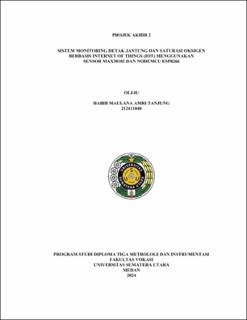Sistem Monitoring Detak Jantung dan Saturasi Oksigen Berbasis Internet of Things (IoT) Menggunakan Sensor MAX30102 dan Nodemcu ESP8266
Heart Rate and Oxygen Saturation Monitoring System Based on The Internet of Things (IoT) Using MAX30102 Sensor and ESP8266 Nodemcu

Date
2024Author
Tanjung, Habib Maulana Amri
Advisor(s)
Ginting, Junedi
Metadata
Show full item recordAbstract
Technological advancements have significantly impacted daily life, especially
in the medical field. The heart, as a vital organ, plays a crucial role in pumping
blood throughout the body, with a normal heart rate ranging between 60-100 bpm.
Maintaining a normal heart rate and adequate oxygen saturation is essential for
optimal health. Arrhythmia, a disorder of heart rhythm, includes tachycardia (>100
bpm) and bradycardia (<60 bpm). Monitoring heart rate and oxygen saturation are
vital health indicators, yet existing medical devices are often expensive and
inaccessible. Therefore, there is a need for affordable and accurate monitoring
devices.
This study developed an Internet of Things (IoT)-based heart rate and oxygen
saturation monitoring device using the MAX30102 sensor and NodeMCU ESP8266.
Data from the sensor is transmitted to the cloud and visualized via smartphone.
Testing showed that this device functions optimally with a 90% accuracy rate. The
system works by detecting heart rate and oxygen saturation when a finger is placed
on the MAX30102 sensor, displaying the results in real-time. The highest recorded
error rates were 0.034% (BPM) and 0.031% (SpO2), with average error rates of
0.0283% (BPM) and 0.0253% (SpO2).
Collections
- Diploma Papers [158]
